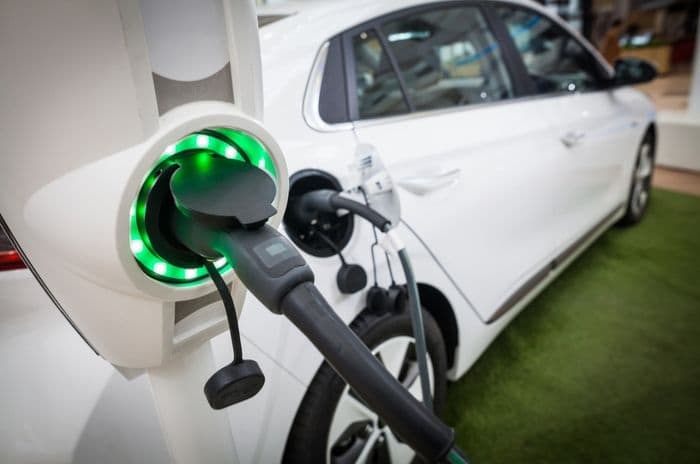Choosing the right electric vehicle and ensuring the cover is adequate for a driver's personal situation can bring premiums down.
It's also important to understand that factors such as parts available and supply chain issues can have their role in making EV insurance more expensive.
Many of these issues should resolve themselves over time as the EV market adapts to the challenges it faces.

Is it more expensive to insure an EV?
Electric vehicle car insurance can be more expensive than covering a vehicle with an internal combustion engine (ICE).
We examine the reasons why this might be later in this guide, but first let's look at research on EV car insurance premiums to see what the differences are.
Data from Admiral
Insurance provider Admiral publishes regular trackers on the insurance premiums paid by their customers. This gives us tangible data on how much EV drivers are paying for their car insurance.
Their data for July 2022 shows:
- EV drivers paid 19% more than Admiral's national average across all car types
- This meant the premium for electric car insurance was £732
On this second point, it's important to highlight that this is data from one insurer and so comparing motor insurance quotes from multiple companies will see customers given a range of prices.
Yet the 19% discrepancy is the crucial figure here, and it demonstrates that, for Admiral's customers at least, EV owners are paying more to insure their cars.
Admiral also provided details of the cheapest and most expensive electric cars to insure, with data again based on their customer experiences as of July 2022.
Here are the five cheapest EVs to insure:
| Electric vehicle | Annual premium | |
|---|---|---|
| 1 | Volkswagen ID | £406.77 |
| 2 | Fiat 500 | £418.46 |
| 3 | Peugeot 208 | £433.76 |
| 4 | MG5 | £441.69 |
| 5 | Renault Zoe | £483.41 |
From this, we can see that the cheapest EVs to insure take around £300 off that average figure discussed above.
As for larger, more sophisticated electric cars, the premiums can be well over £1,000 annually:
| Electric vehicle | Annual premium | |
|---|---|---|
| 1 | Porsche Taycan | £1,312.35 |
| 2 | Tesla Model 3 | £1,211.30 |
| 3 | Tesla Model S | £1,169.78 |
| 4 | Audi E-Tron | £1,138.90 |
| 5 | Jaguar I-PACE | £1,006.87 |
So, as with all vehicles, whether they are electric or not, insurance premiums can vary dramatically around an average figure - and elements we'll discuss later can impact how varied these premiums can be.
Research from GlobalData
We can also look to consumer research from GlobalData's 2021 UK Insurance Consumer Survey that compares the price of EV insurance to ICE insurance.
They separate out insurance premiums for BEV (battery electric vehicle) and HEV (hybrid electric vehicle) models to provide a visual analysis of how much consumers are paying for their insurance.
These are a few of their findings:
- While more than 30% of ICE vehicles had premiums priced around the £300 mark, just over 10% of BEVs had premiums at that level.
- HEVs have a gradual spike around the £400 mark but a smaller spike around the £1,000 mark found around 5% of customers are paying that annually.
- The premiums for BEVs is far more evenly spread, with more customers paying £500 to £1,000 and £1,250+ for their car insurance with this type of vehicle.
From this analysis, then, we find that EV insurance can be as cheap as ICE insurance, yet there is a much bigger range to it.
Why is EV insurance more expensive?
Insurers set premiums based on both expected and unexpected risks.
Fundamentally, there are a couple of overarching issues that make electric vehicles potentially more expensive to insure because the risk of the insurance company needing to pay out is higher - and they may need to pay more out too.
Here are the key issues facing EV insurance:
- Electric vehicles are usually more expensive to begin with, meaning the costs of covering them adequately is higher.
- Technological complexity means an increased cost in damage claims even from comparatively small accidents.
- Limited availability or delays in getting hold of parts due to immature supply chains can result in delays to repairs.
- Repair skills are not yet up to the same level as for non-EV cars.
These are all logical reasons why EV car insurance costs may be more expensive than ICE vehicles, yet it's also worth considering some other elements that might not be as well known to EV consumers.
Car insurance groups
Each car sold in the UK is placed in a car insurance group based on how risky there are perceived to be by insurers.
While premiums aren't solely based on these groups, they provide insurers with a baseline for calculating the overall risk.
Cars in group 1 are deemed to be the least risky, while cars in group 50 are considered to be the riskiest.
Electric cars tend to fall in the mid-range between groups 20 and 30 as the table below demonstrates:
| Make and model | Car insurance group |
|---|---|
| Nissan Leaf Hatchback | 23 |
| Tesla Model S | 50 |
| Volkswagen e-Up Hatchback | 10 |
| Kia e-Niro | 24 |
| Hyundai Kona Electric SUV | 22 |
| BMW i3 | 21 |
| Renault Zoe Hatchback | 18 |
| MG ZS EV SUV | 27 |
These are relatively costly insurance groups and where you might expect to find mid-range cars like the Ford S-MAX or Land Rover Discovery Sport.
For a direct comparison, the car in the lowest group in the table above is the Volkswagen e-Up hatchback, which is in insurance group 10.
If we look at the petrol version of the Volkswagen Up, we find it's in insurance group 1, which is the cheapest to insure.
Leased batteries
Some electric car manufacturers will reduce the purchase price of the car if you lease the battery that powers it.
This benefits the buyer in that when the battery loses some of its capacity, the onus is on the manufacturer to replace it.
This normally happens when capacity drops below 75% of its original rate.
While this may sound appealing, it's important to check with the battery provider just who is responsible for cover in the event of damage.
It's also important to inform your insurer if the battery is leased, as your policy may not cover it.
Some manufacturers may expect you to insure the battery, but others may replace or repair it themselves at no extra cost.
If you need a policy that does include cover for a leased battery, you can expect to pay a little more for your insurance. The opposite is true if you don't need cover.
Public liability
It's worth considering how you're going to charge your car, as this will affect the cost of your premiums.
If you're planning on running a cable from your house to the pavement outside - or using a public charging point - then you'll need adequate liability insurance in case a member of the public trips and injures themselves.
You should contact individual insurers to find out what their policy is with regard to allegations of negligence and personal injury from the public.
For example, some providers will say you're insured against this eventuality as long as you have taken reasonable steps to prevent such an accident occurring. However, the definition of "reasonable steps" may vary from insurer to insurer.
It's also worth finding out what approach insurers take to the charging cables themselves.
Some insurers will only cover the cables bought as part of the car. Aftermarket cables won't be covered unless they're a direct replacement from the manufacturer.
How to get cheaper electric car insurance
Many of the tricks to getting cheaper electric car insurance are the same that apply to getting cheaper car insurance more generally such as:
- Choosing a car in a low insurance group
- Avoiding modifications (unless they improve security)
- Increasing your voluntary excess
- Ensuring parking locations are secure
- Paying annually rather than monthly for insurance
As well as this, though, we've outlined some of the elements of EV insurance that make this type of vehicle more expensive to insure.
Many of the points below will need to be considered when choosing a new EV rather than when you're changing insurer or searching for a new provider for an existing EV:
- Choosing a cheaper (and smaller) EV can result in lower insurance costs
- Picking one of the more popular EVs on the market from a larger manufacturer may result in more parts being available if and when needed
- Understanding your charging needs and how this may affect your insurance can help
It's also worth shopping around for an EV insurance provider too, since more providers are becoming more adept at pricing EV insurance effectively and the market is becoming more competitive.
Summary: Evolving market
The good news is that the electric vehicle insurance market is evolving all the time, much like the overall EV market.
Figures from the 2021 GlobalData report mentioned above show insured BEVs and HEVs are becoming more a part of the UK's vehicle mix:
- 2.8% of customers had a battery electric vehicle, up from 1.9% in 2019
- 6.9% of customers had a hybrid electric vehicle, up from 4.3% in 2019
These figures are growing steadily, so many of the issues we've highlighted in this guide may resolve themselves over time.
Insurers will also have a growing dataset on how risky EVs are in practice compared with ICE vehicles, and how these risks are affected by the typical factors that impact car insurance such as where someone lives, how they use the car and what age they are.
The move towards net zero and the promotion of EVs as an alternative form of transportation means that we should see competitive EV insurance deals springing up from more providers in the future.









Comments